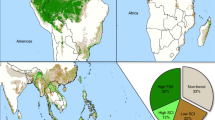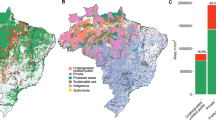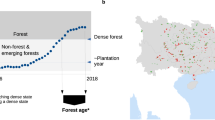Abstract
Tropical dry woodlands are rapidly being lost to agricultural expansion, but how deforestation dynamics play out in these woodlands remains poorly understood. We have developed an approach to detect and map high-level patterns of deforestation frontiers, that is, the expansion of woodland loss across continents in unprecedented spatio-temporal detail. Deforestation in tropical dry woodlands is pervasive, with over 71 Mha lost since 2000 and one-third of wooded areas located in deforestation frontiers. Over 24.3 Mha of deforestation frontiers fall into what we term ‘rampant frontiers’. These are characterized by drastic woodland loss and conditions favourable for capital-intensive agriculture, as seen in the South American Chaco and Southeast Asia. We have found many active and emerging frontiers (~59% of all frontiers), mostly in the understudied dry woodlands of Africa and Asia, where greater frontier monitoring is needed. Our approach enables consistent, repeatable frontier monitoring, and our global frontier typology fosters comparative research and context-specific policymaking.
This is a preview of subscription content, access via your institution
Access options
Access Nature and 54 other Nature Portfolio journals
Get Nature+, our best-value online-access subscription
$29.99 / 30 days
cancel any time
Subscribe to this journal
Receive 12 digital issues and online access to articles
$119.00 per year
only $9.92 per issue
Buy this article
- Purchase on Springer Link
- Instant access to full article PDF
Prices may be subject to local taxes which are calculated during checkout






Similar content being viewed by others
Data availability
All datasets used here are publicly available and are referenced. Data outputs from this study are publicly available on Zenodo at https://doi.org/10.5281/zenodo.6141799. The methodological steps are described in the Methods and Supplementary Information.
Code availability
The code used for the development of frontier metrics, typologies and archetypes in this study is permanently and publicly available on Zenodo at https://doi.org/10.5281/zenodo.6141799.
References
IPBES The IPBES Assessment Report on Land Degradation and Restoration (Secretariat of the Intergovernmental Science-Policy Platform on Biodiversity and Ecosystem Services, 2018).
Barlow, J. et al. Anthropogenic disturbance in tropical forests can double biodiversity loss from deforestation. Nature 535, 144–147 (2016).
The State of the World’s Forests 2020. Forests, Biodiversity and People (FAO and UNEP, 2020).
Pendrill, F. et al. Agricultural and forestry trade drives large share of tropical deforestation emissions. Glob. Environ. Change 56, 1–10 (2019).
Geist, H. J. & Lambin, E. F. What Drives Tropical Deforestation? LUCC Report Series 4 (LUCC International Project Office, 2001).
Austin, K. G., González-Roglich, M., Schaffer-Smith, D., Schwantes, A. M. & Swenson, J. J. Trends in size of tropical deforestation events signal increasing dominance of industrial-scale drivers. Environ. Res. Lett. 12, 054009 (2017).
Graesser, J., Ramankutty, N. & Coomes, O. T. Increasing expansion of large-scale crop production onto deforested land in sub-Andean South America. Environ. Res. Lett. 13, 084021 (2018).
Meyfroidt, P. et al. Middle-range theories of land system change. Glob. Environ. Change 53, 52–67 (2018).
Verburg, P. H. et al. Land system science and sustainable development of the Earth system: a global land project perspective. Anthropocene 12, 29–41 (2015).
Václavík, T. et al. Investigating potential transferability of place-based research in land system science. Environ. Res. Lett. 11, 095002 (2016).
Stocks, G., Seales, L., Paniagua, F., Maehr, E. & Bruna, E. M. The geographical and institutional distribution of ecological research in the tropics. Biotropica 40, 397–404 (2008).
Schröder, J. M., Ávila Rodríguez, L. P. & Günter, S. Research trends: tropical dry forests: the neglected research agenda? For. Policy Econ. 122, 102333 (2021).
Rodrigues, A. S. L. et al. Boom-and-bust development patterns across the Amazon deforestation frontier. Science 324, 1435–1437 (2009).
de Jong, E. B. P., Knippenberg, L. & Bakker, L. New frontiers: an enriched perspective on extraction frontiers in Indonesia. Crit. Asian Stud. 49, 330–348 (2017).
Tyukavina, A. et al. Congo Basin forest loss dominated by increasing smallholder clearing. Sci. Adv. 4, eaat2993 (2018).
Pacheco, P. et al. Deforestation Fronts: Drivers and Responses in a Changing World (WWF, 2021).
Hansen, M. C. et al. High-resolution global maps of 21st-century forest cover change. Science 342, 850–853 (2013).
Oberlack, C. et al. Archetype analysis in sustainability research: meanings, motivations, and evidence-based policy making. Ecol. Soc. https://doi.org/10.5751/ES-10747-240226 (2019).
Sietz, D. et al. Archetype analysis in sustainability research: methodological portfolio and analytical frontiers. Ecol. Soc. https://doi.org/10.5751/ES-11103-240334 (2019).
Václavík, T., Lautenbach, S., Kuemmerle, T. & Seppelt, R. Mapping global land system archetypes. Glob. Environ. Change 23, 1637–1647 (2013).
Vallejos, M. et al. Social-ecological functional types: connecting people and ecosystems in the Argentine Chaco. Ecosystems 23, 471–484 (2020).
Oberlack, C., Tejada, L., Messerli, P., Rist, S. & Giger, M. Sustainable livelihoods in the global land rush? Archetypes of livelihood vulnerability and sustainability potentials. Glob. Environ. Change 41, 153–171 (2016).
Miles, L. et al. A global overview of the conservation status of tropical dry forests. J. Biogeogr. 33, 491–505 (2006).
Pennington, R. T., Lehmann, C. E. R. & Rowland, L. M. Tropical savannas and dry forests. Curr. Biol. 28, R541–R545 (2018).
Ribeiro, N. S., Katerere, Y., Chirwa, P. W. & Grundy, I. M. in Miombo Woodlands in a Changing Environment: Securing the Resilience and Sustainability of People and Woodlands (eds Ribeiro, N. S. et al.) 1–8 (Springer, 2020).
Murphy, B. P., Andersen, A. N. & Parr, C. L. The underestimated biodiversity of tropical grassy biomes. Philos. Trans. R. Soc. B 371, 20150319 (2016).
Chidumayo, E. & Marunda, C. in The Dry Forests and Woodlands of Africa (eds Chidumayo, E. N. & Gumbo, D.) 1–9 (Earthscan, 2010).
Gasparri, N. I. & Grau, H. R. Deforestation and fragmentation of Chaco dry forest in NW Argentina (1972–2007). For. Ecol. Manag. 258, 913–921 (2009).
Miranda, J., Börner, J., Kalkuhl, M. & Soares-Filho, B. Land speculation and conservation policy leakage in Brazil. Environ. Res. Lett. 14, 045006 (2019).
Ingalls, M. L., Meyfroidt, P., To, P. X., Kenney-Lazar, M. & Epprecht, M. The transboundary displacement of deforestation under REDD+: problematic intersections between the trade of forest-risk commodities and land grabbing in the Mekong region. Glob. Environ. Change 50, 255–267 (2018).
Davis, K. F. et al. Tropical forest loss enhanced by large-scale land acquisitions. Nat. Geosci. 13, 482–488 (2020).
Ordway, E. M., Asner, G. P. & Lambin, E. F. Deforestation risk due to commodity crop expansion in sub-Saharan Africa. Environ. Res. Lett. 12, 044015 (2017).
Vancutsem, C. et al. Long-term (1990–2019) monitoring of forest cover changes in the humid tropics. Sci. Adv. 7, eabe1603 (2021).
Sunderland, T. et al. Global dry forests: a prologue. Int. For. Rev. 17, 1–9 (2015).
Grau, H. R. & Aide, M. Globalization and land-use transitions in Latin America. Ecol. Soc. https://doi.org/10.5751/es-02559-130216 (2008).
le Polain de Waroux, Y. et al. Rents, actors, and the expansion of commodity frontiers in the Gran Chaco. Ann. Am. Assoc. Geogr. 108, 204–225 (2018).
Romero-Muñoz, A. et al. Fires scorching Bolivia’s Chiquitano forest. Science 366, 1082 (2019).
Hoang, N. T. & Kanemoto, K. Mapping the deforestation footprint of nations reveals growing threat to tropical forests. Nat. Ecol. Evol. 5, 845–853 (2021).
Eigenbrod, F. et al. Identifying agricultural frontiers for modeling global cropland expansion. One Earth 3, 504–514 (2020).
Nolte, C., le Polain de Waroux, Y., Munger, J., Reis, T. N. P. & Lambin, E. F. Conditions influencing the adoption of effective anti-deforestation policies in South America’s commodity frontiers. Glob. Environ. Change 43, 1–14 (2017).
Volante, J. N. & Seghezzo, L. Can’t see the forest for the trees: can declining deforestation trends in the Argentinian Chaco region be ascribed to efficient law enforcement? Ecol. Econ. 146, 408–413 (2018).
Chirwa, P. W. & Adeyemi, O. in Zero Hunger: Encyclopedia of the UN Sustainable Development Goals (eds Leal Filho, W. et al.) 1–15 (Springer, 2019).
Pacheco, P. Actor and frontier types in the Brazilian Amazon: assessing interactions and outcomes associated with frontier expansion. Geoforum 43, 864–874 (2012).
García, A. K., Meyfroidt, P., Abeygunawardane, D. & Sitoe, A. Waves and legacies: the making of an investment frontier in Niassa, Mozambique. Ecol. Soc. 27, 40 (2022).
Leal, I. R., Da Silva, J. M. C., Tabarelli, M. & Lacher, T. E.Jr Changing the course of biodiversity conservation in the Caatinga of northeastern Brazil. Conserv. Biol. 19, 701–706 (2005).
Osabuohien, E. S. & Karakara, A. A. in The Palgrave Handbook of Agricultural and Rural Development in Africa (ed. Osabuohien, E. S.) 627–640 (Springer, 2020).
Gautier, D., Garcia, C., Negi, S. & Wardell, D. A. The limits and failures of existing forest governance standards in semi-arid contexts. Int. For. Rev. 17, 114–126 (2015).
Brandt, M. et al. An unexpectedly large count of trees in the West African Sahara and Sahel. Nature 587, 78–82 (2020).
Bastin, J. F. et al. The extent of forest in dryland biomes. Science 356, 635–638 (2017).
Fagan, M. E. A lesson unlearned? Underestimating tree cover in drylands biases global restoration maps. Glob. Change Biol. 26, 4679–4690 (2020).
Bey, A. & Meyfroidt, P. Improved land monitoring to assess large-scale tree plantation expansion and trajectories in Northern Mozambique. Environ. Res. Commun. https://doi.org/10.1088/2515-7620/ac26ab (2021).
Harris, N., Goldman, E. D. & Gibbes, S. Spatial Database of Planted Trees (SDPT Version 1.0) (World Resources Institute, accessed 21 November 2021).
Timberlake, W. J., Chidumayo, E. & Sawadogo, L. in The Dry Forests and Woodlands of Africa (eds Chidumayo, E. N. & Gumbo, D.) 11–41 (Earthscan, 2010).
Portillo-Quintero, C. A. & Sánchez-Azofeifa, G. A. Extent and conservation of tropical dry forests in the Americas. Biol. Conserv. 143, 144–155 (2010).
Dinerstein, E. et al. An ecoregion-based approach to protecting half the terrestrial realm. BioScience 67, 534–545 (2017).
Murphy, P. G. & Lugo, A. E. Ecology of tropical dry forest. Annu. Rev. Ecol. Syst. 17, 67–88 (1986).
Lock, J. M. in Neotropical Savannas and Seasonally Dry Forests (eds Pennington, R. T. & Ratter, J. A.) 449–467 (CRC Press, 2006).
Malhi, Y. et al. Megafauna and ecosystem function from the Pleistocene to the Anthropocene. Proc. Natl Acad. Sci. USA 113, 838–846 (2016).
Baldi, G., Veron, S. R. & Jobbagy, E. G. The imprint of humans on landscape patterns and vegetation functioning in the dry subtropics. Glob. Change Biol. 19, 441–458 (2013).
Lahsen, M., Bustamante, M. M. C. & Dalla-Nora, E. L. Undervaluing and overexploiting the Brazilian Cerrado at our peril. Environ. Sci. Policy Sustain. Dev. 58, 4–15 (2016).
Sitoe, A., Chidumayo, E. & Alberto, M. in The Dry Forests and Woodlands of Africa (eds Chidumayo, E. N. & Gumbo, D.) 131–153 (Earthscan, 2010).
Ozdogan, M. & Woodcock, C. E. Resolution dependent errors in remote sensing of cultivated areas. Remote Sens. Environ. 103, 203–217 (2006).
Estes, L. et al. A large-area, spatially continuous assessment of land cover map error and its impact on downstream analyses. Glob. Change Biol. 24, 322–337 (2018).
Dlamini, W. M. Mapping forest and woodland loss in Swaziland: 1990–2015. Remote Sens. Appl. Soc. Environ. 5, 45–53 (2017).
Geist, H. J. & Lambin, E. F. Proximate causes and underlying driving forces of tropical deforestation: tropical forests are disappearing as the result of many pressures, both local and regional, acting in various combinations in different geographical locations. BioScience 52, 143–150 (2002).
Walker, R. Mapping process to pattern in the landscape change of the Amazonian frontier. Ann. Assoc. Am. Geogr. 93, 376–398 (2003).
Baumann, M. et al. Frontier metrics for a process-based understanding of deforestation dynamics. Preprint at EarthArXiv https://doi.org/10.31223/X55S7J (2022).
Curtis, P. G., Slay, C. M., Harris, N. L., Tyukavina, A. & Hansen, M. C. Classifying drivers of global forest loss. Science 361, 1108–1111 (2018).
Lesiv, M. et al. Estimating the global distribution of field size using crowdsourcing. Glob. Change Biol. 25, 174–186 (2019).
Weiss, D. J. et al. A global map of travel time to cities to assess inequalities in accessibility in 2015. Nature 553, 333–336 (2018).
Global Agro-Ecological Zones (GAEZ v3. 0) (IIASA and FAO, accessed 24 July 2020).
Heinimann, A. et al. A global view of shifting cultivation: recent, current, and future extent. PLoS ONE 12, e0184479 (2017).
Shamseer, L. et al. Preferred reporting items for systematic review and meta-analysis protocols (PRISMA-P) 2015: elaboration and explanation. BMJ 349, g7647 (2015).
Acknowledgements
A.B. was supported by the Fundação para a Ciência e a Tecnologia (FCT), IP, through a PhD grant (SFRH/BD/143236/2019). A.B. and T.K. are grateful for financial support of this project through a start-up grant by Humboldt-University Berlin. This project received funding from the European Research Council (ERC) under the European Union’s Horizon 2020 research and innovation programme (projects 677140 MIDLAND to P.M. and 101001239 SYSTEMSHIFT to T.K.). This work contributes to the Global Land Programme (https://glp.earth).
Author information
Authors and Affiliations
Contributions
A.B., T.K., M.B. and P.M. conceived the research idea. A.B. and M.B. collected the data. A.B. led the design of the analytical framework, the data analysis and the writing. M.B., P.M. and T.K. contributed to the interpretation of results and the writing of the manuscript.
Corresponding author
Ethics declarations
Competing interests
The authors declare no competing interests.
Peer review
Peer review information
Nature Sustainability thanks Mário Marcos do Espírito Santo, Ole Mertz and the other, anonymous, reviewer(s) for their contribution to the peer review of this work.
Additional information
Publisher’s note Springer Nature remains neutral with regard to jurisdictional claims in published maps and institutional affiliations.
Supplementary information
Supplementary Information
Supplementary Figs. 1–8, Tables 1–3, Text 1 and 2, and references.
Rights and permissions
About this article
Cite this article
Buchadas, A., Baumann, M., Meyfroidt, P. et al. Uncovering major types of deforestation frontiers across the world’s tropical dry woodlands. Nat Sustain 5, 619–627 (2022). https://doi.org/10.1038/s41893-022-00886-9
Received:
Accepted:
Published:
Issue Date:
DOI: https://doi.org/10.1038/s41893-022-00886-9
This article is cited by
-
Trait-mediated filtering predicts phyllostomid bat responses to habitat disturbance in the Orinoco Llanos
Biodiversity and Conservation (2024)
-
Protected areas reduce deforestation and degradation and enhance woody growth across African woodlands
Communications Earth & Environment (2023)
-
Past and future adverse response of terrestrial water storages to increased vegetation growth in drylands
npj Climate and Atmospheric Science (2023)
-
Agricultural intensification, Indigenous stewardship and land sparing in tropical dry forests
Nature Sustainability (2023)
-
Is the EU shirking responsibility for its deforestation footprint in tropical countries? Power, material, and epistemic inequalities in the EU’s global environmental governance
Sustainability Science (2023)



